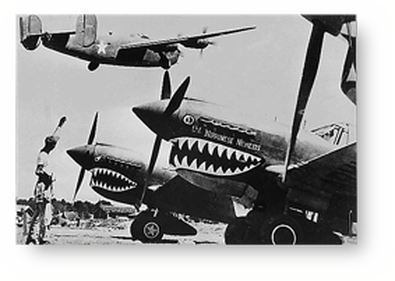Stories From the Front
Courtesy of ProQuest National Archives
Excerpts from phone/email interview with Bud Hiner:
Prior to 1941 Pearl Harbor Japan had taken over Manchuria and Korea, but also northeastern China including Peking (now Bejing) and the port of Shanghia and Canton. Japan had left the League of Nations and built up their military to 65 army divisions and the largest navy and air force in the pacific. At Pearl Harbor their intentions were to take over the whole Pacific areas. On December 7th they attacked Pearl Harbor to keep our navy from interfering with their efforts to take over the south pacific countries. At the same time that they attack Pearl Harbor, they invaded Hong Kong, Thailand, French Indo-China, which included Vietnam, Cambodia and Laos. also British Singapore and Malasia western Borneo and also the Philipines. Then from Thailand they moved over to Burma to cut of the route to China from the Port of Rangoon. The flying tigers were driven out of Rangoon and moved up to the northern part of Burma, then over to Kunming.
Excerpts from phone interview with Melvin (Mel) Mc Mullen:
"Another time that comes to memory—we were bombing a railroad marshaling yard and my position as the nose gunner right up front—I could see everything. This train was chugging out of the railroad marshaling yards trying to pick speed to keep ahead of the bombs but they didn’t make it. What we had found when we got back to our base, we can’t say whether it was my plane or the one beside us-but it turns out what we had bombed was a munitions train that blew up and caused enough damage that the Japanese were not only denied the supplies in the train it also caused such damage that we knew they couldn’t use those tracks or those marshaling yards for some time. That was a very successful raid."
"Our biggest problem was the drain we had to fly over, over the Himalayan mountains, they called “The Hump”. The weather brought down planes practically every day. The thing we had to really contend with was the ground fighter the anti-air craft fighter over every target and the extreme weather conditions and getting back home with enough gas. One time it was a pretty close call we were all we were running out of gas and we were all given the orders to stand by to bail out and finally our radio operator made a contact with a base that we were able to land on and before we got into the runway two of our engines had cut out. So rather than the enemy fighter planes, the extreme weather and anti-air craft fighters were what we were really concerned with."
Excerpts from Book "God is My Co Pilot":
"When the enemy planes approached Kunming , Cooper left the Hospital and took charge of the defense at the home base. He sent Schel's Squadron towards the South at exactly the right time. They not only intercepted the enemy and foiled the attack but shot down eight of the enemy. That made the score for the Group twenty-seven enemy planes on October 25th, and three highly successful bombing raids."
Copyright

